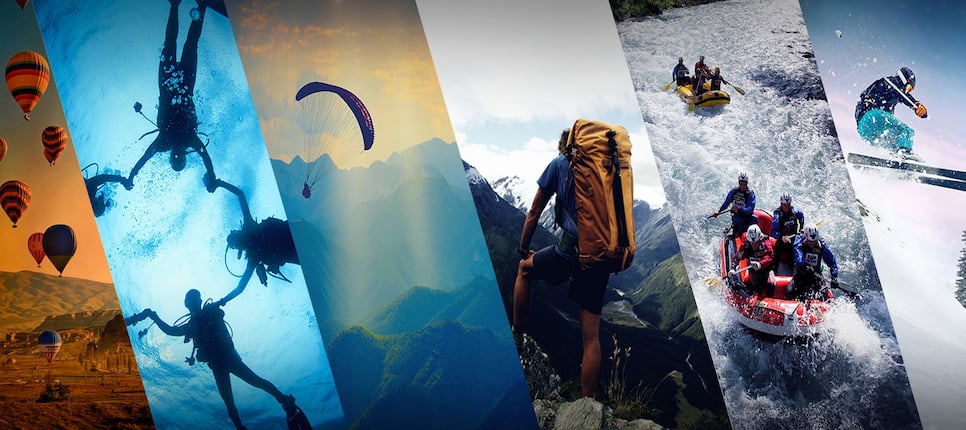Adventure trips for seniors redefine the concept of travel, offering exciting and fulfilling experiences tailored to various fitness levels and preferences. This exploration delves into the planning, logistics, and safety aspects of crafting unforgettable adventures for older travelers, showcasing diverse destinations and activity options. Whether it’s a relaxing cultural cruise or a moderately challenging hike through breathtaking landscapes, we aim to inspire and empower seniors to embark on the adventure of a lifetime.
From carefully selected destinations catering to accessibility needs to practical advice on budgeting and health considerations, this guide provides a comprehensive roadmap for seniors looking to embrace the thrill of exploration. We’ll cover everything from choosing the right tour operator to understanding travel insurance and emergency preparedness, ensuring a safe and enriching experience for every senior adventurer.
Defining “Adventure Trips” for Seniors
Adventure trips for seniors redefine the concept of adventure, prioritizing safety, accessibility, and enjoyment over extreme physical challenges. It’s about embracing new experiences and fostering a sense of accomplishment, tailored to individual capabilities and preferences. The focus shifts from conquering a peak to savoring the journey and the unique perspectives it offers.
Adventure travel for seniors encompasses a wide spectrum of activity levels, catering to diverse fitness capabilities. From gentle strolls through picturesque landscapes to more invigorating hikes, the options are abundant. The key is to find the right balance between challenge and comfort, ensuring a rewarding and safe experience.
Activity Levels and Examples
Defining appropriate activity levels is crucial for senior adventure trips. Low-impact activities minimize stress on joints and muscles, while high-impact options offer a greater physical challenge for those with higher fitness levels. Careful consideration of individual capabilities and medical conditions is paramount.
| Activity | Fitness Level | Accessibility Considerations | Example Locations |
|---|---|---|---|
| Guided Nature Walk | Low | Even terrain, well-maintained paths, rest stops | National Parks (e.g., Acadia National Park, with accessible trails), Botanical Gardens |
| Gentle Kayak Tour | Low to Moderate | Stable kayaks, calm waters, assistance for entry/exit | Coastal areas with sheltered bays (e.g., Florida Keys), inland lakes |
| Scenic Train Journey | Low | Accessible train cars, assistance with boarding | Rocky Mountaineer (Canada), Switzerland’s scenic routes |
| Moderate Hiking | Moderate to High | Well-marked trails, manageable inclines, appropriate footwear | Appalachian Trail (sections with gentler slopes), National Parks with varying trail difficulty |
| Wildlife Safari | Low to Moderate | Accessible vehicles, comfortable seating, potential for longer travel days | Tanzania’s Serengeti, South Africa’s Kruger National Park (with adapted vehicles) |
Accessibility and Adaptive Options
Accessibility is a cornerstone of inclusive adventure travel for seniors. This includes ensuring that locations, transportation, and activities are adaptable to a wide range of physical abilities. Adaptive options, such as wheelchair-accessible transportation, modified equipment, and personalized support, are essential for creating truly inclusive experiences. Many organizations now specialize in providing accessible adventure travel, demonstrating a growing commitment to inclusivity within the industry.
Planning and Logistics of Senior Adventure Trips
Planning a senior adventure trip requires meticulous attention to detail, ensuring a safe, enjoyable, and memorable experience. This involves careful consideration of various factors, from choosing the right destination and activities to managing travel logistics and health concerns. A well-structured plan minimizes stress and maximizes the chances of a successful adventure.
Step-by-Step Guide to Planning a Senior Adventure Trip
Effective trip planning involves a series of sequential steps. First, define the trip’s purpose and desired level of adventure. Then, research potential destinations considering accessibility, climate, and activities suitable for seniors. Next, create a detailed itinerary, including travel arrangements, accommodation bookings, and activity schedules. Finally, confirm all bookings and prepare essential documents and packing lists. Thorough preparation minimizes unexpected issues and enhances the overall experience.
Essential Travel Documents and Health Considerations
Before embarking on any adventure trip, gathering essential travel documents is crucial. This includes a valid passport or driver’s license, copies of travel insurance information, flight/train tickets, hotel confirmations, and any necessary visas. Furthermore, consulting your physician for a pre-trip health check-up is highly recommended. Discuss any existing health conditions and obtain necessary vaccinations or medications. Carrying a detailed medical history, including a list of current medications and allergies, is also advisable for emergencies.
Importance of Travel Insurance and Emergency Preparedness
Comprehensive travel insurance is paramount for senior adventurers. It provides financial protection against unforeseen circumstances, such as medical emergencies, trip cancellations, or lost luggage. Consider a policy that covers medical evacuation, repatriation, and emergency medical expenses. In addition to insurance, creating a detailed emergency plan is essential. This includes identifying emergency contacts, sharing your itinerary with family or friends, and knowing the location of the nearest medical facilities. A well-defined emergency plan mitigates potential risks and provides peace of mind.
Examples of Packing Lists Tailored to Different Types of Adventure Trips
Packing lists should be tailored to the specific type of adventure trip. For a hiking trip, this might include comfortable hiking boots, moisture-wicking clothing, a rain jacket, sunscreen, a hat, a walking stick, and a first-aid kit. For a cruise, the list could focus on light clothing, swimwear, comfortable walking shoes, and formal wear for evenings. A wildlife safari might necessitate binoculars, a wide-brimmed hat, lightweight long pants, and insect repellent. Remember to pack any necessary medications and personal items. A well-organized packing list ensures you have everything needed for a comfortable and safe journey.
Budgeting and Financing Senior Adventure Trips
Planning a senior adventure trip requires careful consideration of the financial aspects. Understanding the various ways to fund your trip and employing cost-effective strategies are crucial for ensuring a memorable and stress-free experience. This section will explore different funding options, cost-saving techniques, and insurance considerations to help you budget effectively.
Financing Senior Adventure Trips
Several avenues exist for financing a senior adventure trip. Many seniors utilize their personal savings accumulated over years of work. This offers the greatest flexibility and control over spending. Alternatively, pre-packaged travel deals often offer inclusive pricing, bundling flights, accommodation, and some activities. These packages can provide value, especially for popular destinations. Another option is to explore travel financing options, such as low-interest travel credit cards or personal loans, though it’s crucial to manage debt responsibly. Finally, some seniors may consider utilizing retirement funds, but careful consideration of tax implications and potential penalties should be made before proceeding.
Cost-Effective Travel Strategies
Budgeting effectively is key to making a senior adventure trip feasible. One strategy is to travel during the shoulder season (spring or fall), when prices for flights and accommodation are generally lower than during peak seasons. Consider choosing less popular destinations; while iconic locations are appealing, exploring lesser-known areas often offers similar experiences at a fraction of the cost. Booking flights and accommodation well in advance can also lead to significant savings. Looking for discounts for seniors offered by airlines, hotels, and tour operators can further reduce expenses. Opting for budget-friendly accommodation like guesthouses or Airbnb instead of luxury hotels can also save money. Finally, prioritizing free or low-cost activities such as hiking, exploring local parks, or visiting free museums can significantly reduce the overall trip cost.
Travel Insurance for Senior Travelers
Travel insurance is a critical aspect of planning a senior adventure trip. Several options exist, each with its benefits and drawbacks. Basic travel insurance covers trip cancellations, medical emergencies, and lost luggage. Comprehensive plans offer broader coverage, including emergency medical evacuation, which is particularly important for seniors with pre-existing health conditions. Consider the level of coverage needed based on your health, planned activities, and destination. For example, a trip involving strenuous activities in a remote location necessitates more comprehensive coverage than a relaxed trip to a nearby city. While more comprehensive plans cost more, the peace of mind they provide can be invaluable. Reviewing policy details carefully before purchasing is essential to understand exclusions and limitations.
Sample Budget for a Week-Long Trip
This sample budget outlines potential expenses for a week-long trip for one person. Costs will vary significantly based on destination, travel style, and personal preferences.
| Expense Category | Estimated Cost |
|---|---|
| Flights | $800 – $1500 |
| Accommodation (7 nights) | $700 – $1400 |
| Activities and Tours | $500 – $1000 |
| Food and Drinks | $400 – $800 |
| Transportation (local) | $100 – $300 |
| Travel Insurance | $100 – $200 |
| Miscellaneous Expenses | $100 – $200 |
| Total Estimated Cost | $2600 – $5400 |
Note: This is a sample budget and actual costs may vary significantly. It’s crucial to research specific costs for your chosen destination and tailor the budget accordingly.
Final Review
Ultimately, adventure trips for seniors are not just about ticking off destinations on a bucket list; they’re about enriching lives, fostering personal growth, and creating lasting memories. By carefully considering individual fitness levels, accessibility needs, and personal preferences, seniors can confidently plan and enjoy incredible adventures that expand their horizons and celebrate the spirit of exploration. Remember that responsible planning and a proactive approach to safety are key to ensuring a fulfilling and memorable journey.




